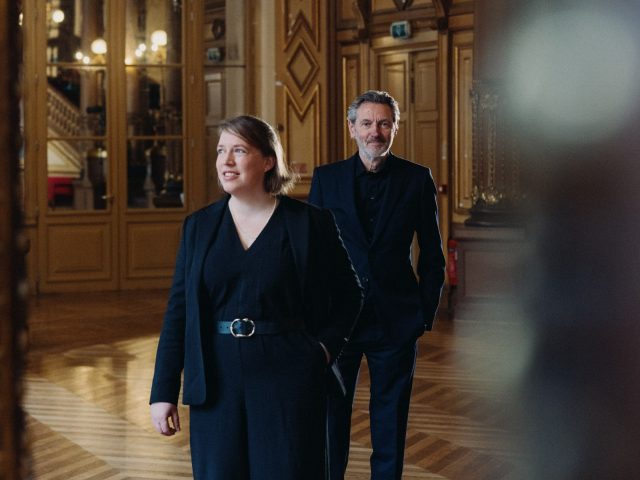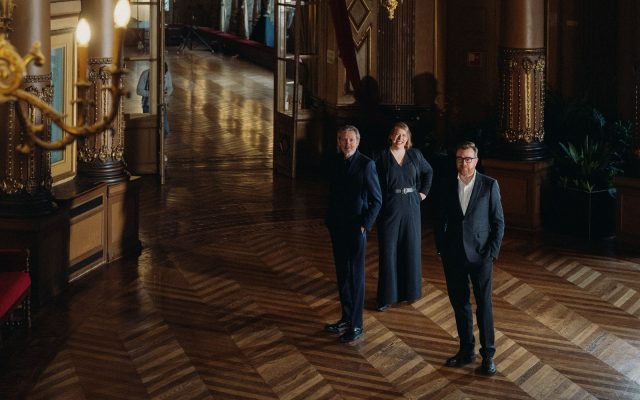- Interview
- Season 25/26
‘It's going to be an unforgettable season’
by Ilse Degryse / Pitcures by Wouter Van Vooren, Wed, May 7, 2025

Looking ahead to season 25/26, Jan Raes introduces our new deputy general director Benedikt Spierings. Together they take stock of Opera Ballet Vlaanderen anno 2025. 'We have a good feeling. Panta rhei, everything is flowing, everything is in motion. As a result, we are reaching a more diverse and wider audience.'
Jan, we've known you for a while as general director of OBV, but Benedikt is a new face to many in the audience. Would you introduce her?
JAN With pleasure. During the COVID period, we had the chance to address some overdue internal matters. At that time, artistic director Jan Vandenhouwe, then deputy general director Kiki Vervloessem, and I created the role of manager for central planning and production. Benedikt Spierings took on that role and implemented efficient processes from which we greatly benefit as the largest arts institution in Flanders. When Kiki Vervloessem left our organization last year for a new future, Benedikt was able to promote—after a rigorous selection process—to deputy general director - COO. We are very happy about that. Benedikt brings great added value as a process thinker and combines that with a warm heart for the arts as a musicologist and violinist.
BENEDIKT This new position comes at a perfect time for me, after four years at OBV during which I discovered what an incredible organization this is and how much knowledge, expertise, and potential it holds. Behind every door you open, there's a whole new world to explore, filled with valuable discoveries. It’s never boring and always adventurous. In my previous role, together with colleagues, I developed a methodology that fostered better collaboration and more efficiency, which created more space for the artistic creation process. It’s very rewarding to continue that dynamic in my new role, with a whole new horizon to explore.
How are things going at OBV in 2025?
JAN We have a good feeling. Panta rhei, everything flows, everything is in motion. This allows us to reach a more diverse and broader audience, which is not always easy with our bold programming. We present masterpieces from the past 400 years with historical knowledge and a contemporary perspective, and we also create entirely new works.
BENEDIKT I completely agree with the image of OBV as an organization in motion, constantly relating to a changing world. We connect tradition with innovation, presenting stories of hardship, loss, and despair alongside hopeful and utopian visions of courage, love, dreams, and connection.
JAN It all starts with artistic dedication and intrinsic quality. We have a unique composition of ensembles. We’re the only institution in the Benelux with all disciplines under one roof: an orchestra, a choir, a ballet, and a children’s choir. With these, we bring relevant performances with a societal angle. We notice that our work is increasingly appreciated both domestically and internationally, including in international media.
BENEDIKT Compared to other organizations, an arts institution is unique in that we can create a collective experience. For the audience, that begins the moment they step into a performance, but for the staff and artists at OBV, the process begins years earlier. In that sense, we’re privileged: it’s incredibly rewarding to collaborate on a project that comes to life, resonates, mirrors, and sparks the imagination—a total sensory experience.
JAN That brings a lot of pride internally. There is constant interaction between the artistic disciplines and crafts that are united here.
BENEDIKT What fascinates me about our production process is how performances emerge from the collaboration of specialists, each with their own expertise and mastery. By layering all those building blocks together, new and surprising perspectives emerge. When everything finally merges into a performance, each visitor interprets it in their own way. The artwork comes to life again and again.
JAN There’s no routine, no repetition. The audience can feel, hear, see, and even smell that.
'Through our Vonk pillar, we also work hard to connect youth with our art forms.'
- Benedikt Spierings
That’s beautiful, but some question if it’s still relevant today...
BENEDIKT I believe our art forms are becoming more valuable in this era of artificial intelligence, individualism, and increasing polarization. The artisanal and tactile work of our ateliers, artists, and technicians contrasts with the increasingly digital and detached world around us. The shared experience we offer in our venues counters the growing individualism. These contrasts make an audience experience at OBV so appealing and meaningful today.
JAN Those contrasts are very human and create engagement.
BENEDIKT And we deliver everything at the highest level—our ensembles, artists, technicians, ateliers, and the entire operation behind them.
Aside from audiences and staff, local and regional governments are key partners for OBV in an increasingly complex world. What opportunities and challenges do you see?
JAN We have a good relationship with policymakers. I dare say that OBV is beloved across the political spectrum. That appreciation grew during COVID, when the importance of the arts for society became clear. I hope we can make further progress in dialogue with new policymakers to develop a long-term vision. That remains a challenge. OBV has a European reputation, but to maintain that, choices will need to be made. For instance, we should consider less fragmentation of limited funds in the arts landscape. Strong collaboration with education and an ambitious public broadcaster that avoids complacency are essential too—they shape the youth and thus our future audience. Education, media, and the arts are three partners that can't exist without each other. I dream of a Flanders where culture, media, and education are united under one minister. That’s the only way for our small region to preserve its diversity of voices within Europe.
Let’s talk about Ghent, where the opera house will close in January 2026 for major renovations.
JAN Our dream for the Ghent opera house—which dates from 1840 and is one of the most beautiful in Europe—is indeed becoming a reality. The plans have been approved by the authorities. We intend to open the building seven days a week, all day long, for residents, visitors, and tourists. There will be more opportunities to attend guided tours and rehearsals. Cultural partners will also have more access to the space for their creations.
What will the building look like in five years?
JAN From the Schouwburgstraat to the Ketelvest, it will be walkable—you’ll be able to walk through the opera house. The entrance will move to where the colonnaded peristyle is now, where the carriages used to pull up. There will be catering, and we’ll build a new 300-seat hall with top-notch acoustics. Ghent will get a side stage like Antwerp. The stage tower will match the height of Antwerp’s, enabling easier transfers of productions between cities.
BENEDIKT That will save time, boost efficiency, and be much more sustainable. The building will also be more inclusive. Currently, there’s only a small lift for people with mobility issues, but the redesigned building will allow everyone easy access.
JAN During the temporary closure, our Ghent audience won’t be left out. We’ll present shows at the Capitole, Bijloke, NTGent, MIRY Concert Hall, Concertgebouw Brugge, and Opéra de Lille. You can read all about it in this brochure.
BENEDIKT And while we’re dreaming... can I go a step further? We hope to eventually have a production center in Antwerp where all artistic groups and work shops—now spread across four locations in three cities—can be brought together to collaborate and rehearse more efficiently, allowing for more performances in Ghent and Antwerp. We’ve already started by centralizing our digital documentation, but nothing beats the live encounter—seeing and hearing each other in the same building.
JAN One day, this has to become a reality...
Our dream for the Ghent opera house—which dates from 1840 and is one of the most beautiful in Europe—is indeed becoming a reality.
- Jan Raes
OBV already has many Friends and Ambassadors, but we’re eager to welcome more.
JAN Absolutely—they’re vital to us. They are our foundation for the future. Especially in a turbulent and changing environment, they provide essential support for OBV. We want to expand the loyal circle of Friends and Ambassadors to include more Ballet and Vonk attendees and younger audiences.
BENEDIKT This house is full of stories, and we want to tell them more intensively and with deep involvement to as many people as possible. Opera and ballet are unfairly seen as unaffordable and elitist. Our Friends program helps break that stereotype.
And it’s just fun to be a Friend, right?
JAN Nothing beats sharing special experiences with others. As a Friend, you become part of a community. You get behind-the-scenes insights into our fascinating world.
You also have many youth initiatives.
JAN It’s a both-and story: of course we love our older audiences, but we’re also focusing strongly on youth with various discounts. Under 26? You get 50% off subscriptions. Under 35? That’s 30%. Last-minute tickets are only €15. We also offer group rates for schools and universities. Together with our partner the National Lottery, we’re rolling out a program to give young people a permanent place in our theatres.
BENEDIKT Through our Vonk pillar, we also work hard to connect youth with our art forms. We know they return once they’ve experienced the magic. Vonk also supports talent development and addresses themes relevant to youth and other target groups. Think of Barzakh, a powerful glimpse into life and survival in a Belgian prison in 2025.
As we welcome Benedikt, we also say farewell to our music director Alejo Pérez. What is his legacy in OBV?
JAN Alejo has been of great value. He brings international experience and masters the monumental late-Romantic and Expressionist repertoire. That’s not a given—it requires technical know-how, solid preparation, and efficient use of time. Alejo also has charisma and leads the orchestra in a non-sentimental, analytical way. He’s very much a conductor of our time. We’ll definitely see him return as a guest conductor. Before he leaves, he’ll conduct Parsifal and a farewell concert with Beethoven’s Sixth Symphony and Mahler’s Das Lied von der Erde.
Finally, the toughest question: what are you most looking forward to this season?
BENEDIKT It’s a beautiful program with a theme that fits us well: asking questions and seeking connection through rituals. All our productions invite reflection and outreach. I’m especially looking forward to Carmen, which brings together all the strengths of our house—choir, orchestra, children’s choir, and dancers. We’ll perform in Concertgebouw Brugge for the first time, adding new energy. I expect choreographer Wim Vandekeybus to bring a fresh take on this classic opera. So I predict: Carmen will be top-tier—adventurous, contemporary, yet rooted in tradition. Every inch OBV.
JAN Great choice... (laughs) It’s going to be an unforgettable season. I’m a Wagner fanatic, so I can’t imagine a better season opener than Parsifal. I’m personally excited about L’uomo dal fiore in bocca, the only opera by Luc Brewaeys. We’ll perform it in concert as part of his foundation’s anniversary year, alongside musical partners. Luc was a childhood friend—we played in a youth orchestra together. I followed his work until his death in 2015. He’s one of Belgium’s most important composers. I’ve programmed and commissioned his work throughout my career. I’m also looking forward to Benjamin Abel Meirhaeghe’s take on Stravinsky’s Le Sacre du printemps. I think Le Sacre is one of the greatest music compositions ever, not just of the 20th century. The choreography by Pina Bausch knocked me out before. Now, the exciting question is how Benjamin and drummer Lander Gyselinck will create a future version.
Discover season 25/26
